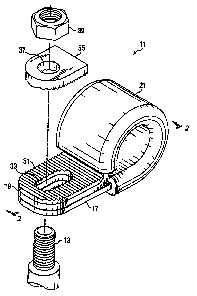Some of the information on this Web page has been provided by external sources. The Government of Canada is not responsible for the accuracy, reliability or currency of the information supplied by external sources. Users wishing to rely upon this information should consult directly with the source of the information. Content provided by external sources is not subject to official languages, privacy and accessibility requirements.
Any discrepancies in the text and image of the Claims and Abstract are due to differing posting times. Text of the Claims and Abstract are posted:
| (12) Patent: | (11) CA 2462287 |
|---|---|
| (54) English Title: | LATERALLY ADJUSTABLE CLAMP |
| (54) French Title: | COLLIER DE SERRAGE A REGLAGE LATERAL |
| Status: | Term Expired - Post Grant Beyond Limit |
| (51) International Patent Classification (IPC): |
|
|---|---|
| (72) Inventors : |
|
| (73) Owners : |
|
| (71) Applicants : |
|
| (74) Agent: | SMART & BIGGAR LP |
| (74) Associate agent: | |
| (45) Issued: | 2010-12-14 |
| (22) Filed Date: | 2004-03-25 |
| (41) Open to Public Inspection: | 2004-10-09 |
| Examination requested: | 2009-03-09 |
| Availability of licence: | N/A |
| Dedicated to the Public: | N/A |
| (25) Language of filing: | English |
| Patent Cooperation Treaty (PCT): | No |
|---|
| (30) Application Priority Data: | ||||||
|---|---|---|---|---|---|---|
|
A clamp that is laterally positionable with respect to a fastener includes a clamp body including a pair of opposable legs. Each of the legs includes an elongated hole adapted to movably engage the fastener. One of the legs includes a locking surface. A locking washer is engageable with the locking surface of the clamp body leg. The locking washer includes a hole that is adapted to fixedly engage the fastener. When engaged with the fastener, the locking washer fixes the lateral position of the clamp body with respect to the fastener.
Collier de serrage qui se place latéralement par rapport à une pièce de fixation, comprenant un collier de serrage et une paire de pattes opposées. Chacune des pattes comporte un trou allongé conçu pour loger la pièce de fixation et lui permettre de bouger. Une des pattes comprend une surface de blocage. Une rondelle de blocage peut se fixer à la surface de blocage de la patte du collier de fixation. La rondelle de blocage comporte un trou conçu pour fixer la pièce de fixation. Lorsqu'elle est fixée à la pièce de fixation, la rondelle de blocage maintient la position latérale du collier de fixation par rapport à la pièce de fixation.
Note: Claims are shown in the official language in which they were submitted.
Note: Descriptions are shown in the official language in which they were submitted.

2024-08-01:As part of the Next Generation Patents (NGP) transition, the Canadian Patents Database (CPD) now contains a more detailed Event History, which replicates the Event Log of our new back-office solution.
Please note that "Inactive:" events refers to events no longer in use in our new back-office solution.
For a clearer understanding of the status of the application/patent presented on this page, the site Disclaimer , as well as the definitions for Patent , Event History , Maintenance Fee and Payment History should be consulted.
| Description | Date |
|---|---|
| Inactive: Expired (new Act pat) | 2024-03-25 |
| Common Representative Appointed | 2019-10-30 |
| Common Representative Appointed | 2019-10-30 |
| Change of Address or Method of Correspondence Request Received | 2018-01-12 |
| Inactive: Agents merged | 2015-11-05 |
| Grant by Issuance | 2010-12-14 |
| Inactive: Cover page published | 2010-12-13 |
| Pre-grant | 2010-10-01 |
| Inactive: Final fee received | 2010-10-01 |
| Letter Sent | 2010-04-12 |
| Notice of Allowance is Issued | 2010-04-12 |
| Notice of Allowance is Issued | 2010-04-12 |
| Inactive: Approved for allowance (AFA) | 2010-03-31 |
| Amendment Received - Voluntary Amendment | 2009-05-27 |
| Letter Sent | 2009-04-24 |
| All Requirements for Examination Determined Compliant | 2009-03-09 |
| Request for Examination Received | 2009-03-09 |
| Request for Examination Requirements Determined Compliant | 2009-03-09 |
| Inactive: IPC from MCD | 2006-03-12 |
| Inactive: IPC from MCD | 2006-03-12 |
| Application Published (Open to Public Inspection) | 2004-10-09 |
| Inactive: Cover page published | 2004-10-08 |
| Inactive: First IPC assigned | 2004-09-20 |
| Inactive: IPC assigned | 2004-09-20 |
| Revocation of Agent Requirements Determined Compliant | 2004-07-08 |
| Inactive: Office letter | 2004-07-08 |
| Inactive: Office letter | 2004-07-08 |
| Appointment of Agent Requirements Determined Compliant | 2004-07-08 |
| Revocation of Agent Request | 2004-05-20 |
| Appointment of Agent Request | 2004-05-20 |
| Inactive: Filing certificate - No RFE (English) | 2004-04-28 |
| Letter Sent | 2004-04-28 |
| Application Received - Regular National | 2004-04-28 |
There is no abandonment history.
The last payment was received on 2010-03-03
Note : If the full payment has not been received on or before the date indicated, a further fee may be required which may be one of the following
Patent fees are adjusted on the 1st of January every year. The amounts above are the current amounts if received by December 31 of the current year.
Please refer to the CIPO
Patent Fees
web page to see all current fee amounts.
Note: Records showing the ownership history in alphabetical order.
| Current Owners on Record |
|---|
| BELL HELICOPTER TEXTRON, INC. |
| Past Owners on Record |
|---|
| STANLEY KENNETH MESSINGER |